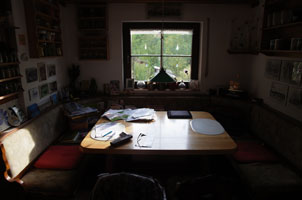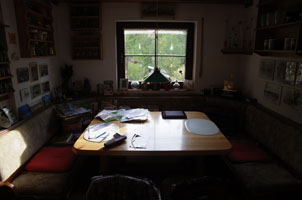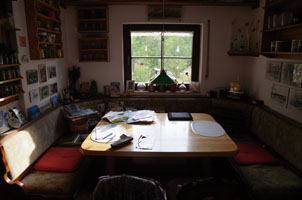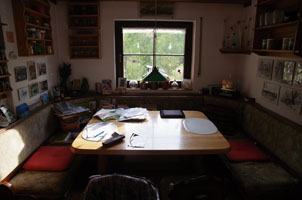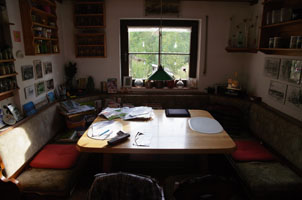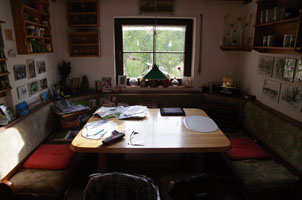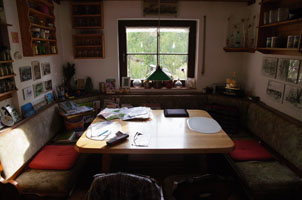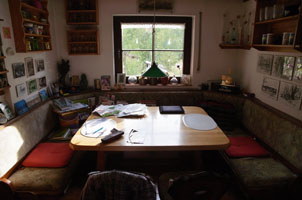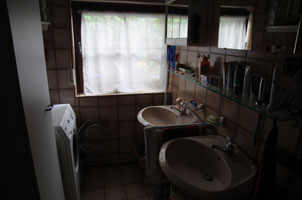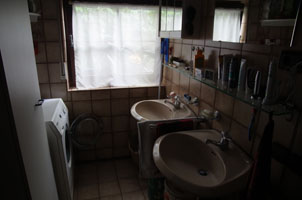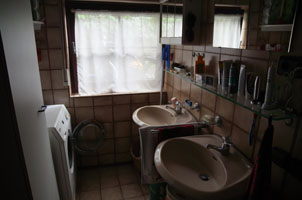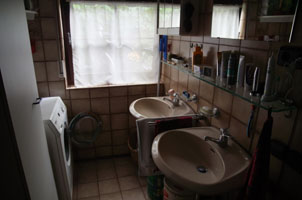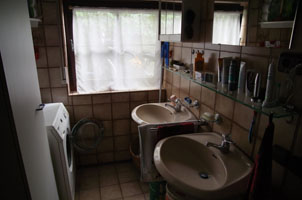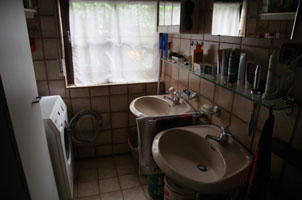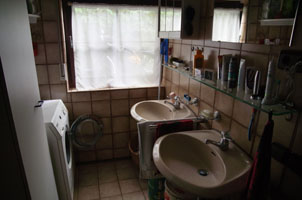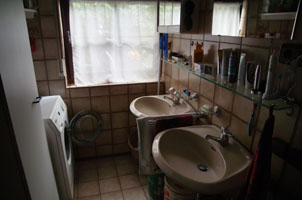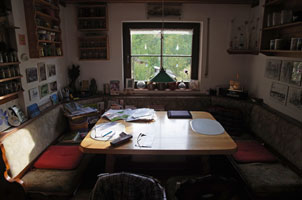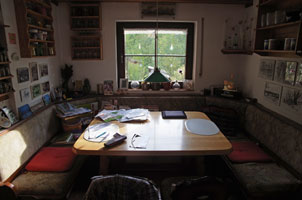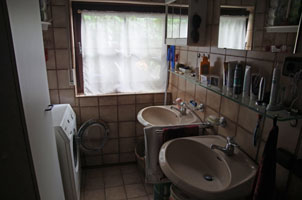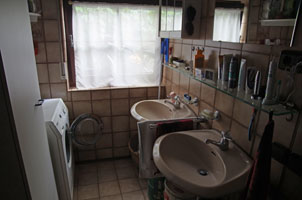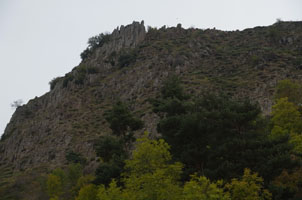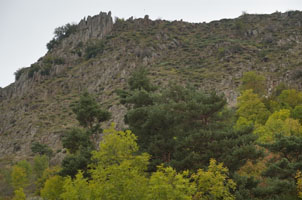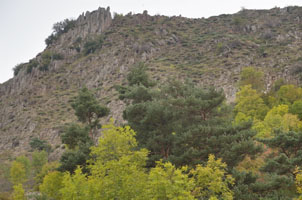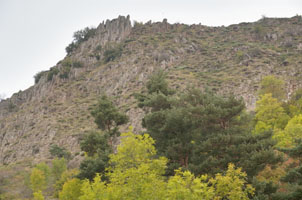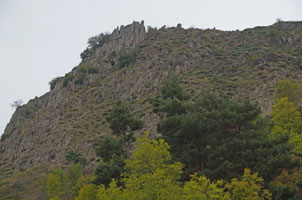Ricoh GXR: Dynamic Range Compensation Comparisons - A16 24-85
On this page, I compare different intensities of dynamic range (DR) compensation for the A16 24-85 camera unit with indoor photos. I find the dynamic range compensation option quite useful in "everyday photography" for backlit scenes.
There are four different levels or intensities of dynamic range compensation: "off", "weak", "medium", and "strong" (I added them them the "Adjust" settings for easier access). While there is a visible difference between the "off" and "weak" settings, I could not find a pronounced difference between "weak" and "medium". As to be expected, the "strong" setting shows the most recognizable difference to "off", but sometimes it leads to a yellowish tint. In general, the hue shift is the more pronounced, the more intensive the dynamic range is compensated. Processing may also take a few seconds for this setting, while the other settings cause shorter delays. That is, processing takes the longer, the more intensive the dynamic range is compensated. Mostly, I use the "strong setting", but usually, I also take an additional photo in the "off" setting because you never know...
The dynamic range compensation restricts the usable ISO values - the more, the stronger the intensity of the compensation:
| Intensity | ISO Step Setting 1/3EV | ISO Step Setting 1EV |
| Weak | ISO 400 to ISO 2000 | ISO 400 to ISO 1600 |
| Medium | ISO 500 to ISO 1600 | ISO 800 to ISO 1600 |
| Strong | ISO 640 to ISO 1250 | ISO 800 |
Because I set the ISO steps to 1EV, I have only ISO 800 available for strong DR compensation. Sometimes that puzzles me because I usually had set another ISO value, and I start wondering... However, as soon as I turn DR compensation "off", the camera returns to the original ISO setting.
Note: The CX series also has a dynamic range option. These cameras take, however, two photos to create a photo with greater dynamic range, which implies that the function is only useful for static scenes. For the A16 24-85 camera unit, there is no mentioning of two photos and this restriction should therefore not apply.
BTW: When I had the Sony Alpha 100, I used the DR option as default because I found the images otherwise too dark in the shades.
Indoor Samples
The following two scenes, each was photographed twice and one series after the other, demonstrate the differences between the dynamic range compensation intensities for the A16 24-85 camera unit. Click the images for larger views.
Please inspect the original files for details.
Scene 1
|
A16 24-85, 24 mm, DR off (original) |
A16 24-85, 24 mm, DR off (original) |
|
A16 24-85, 28 mm, 24 mm, DR weak (original) |
A16 24-85, 24 mm, DR weak (original) |
|
A16 24-85, 24 mm, DR medium (original) |
A16 24-85, 24 mm, DR medium (original) |
|
A16 24-85, 24 mm, DR strong (original) |
A16 24-85, 24 mm, DR strong (original) |
Scene 2
|
A16 24-85, 24 mm, DR off (original) |
A16 24-85, 24 mm, DR off (original) |
|
A16 24-85, 24 mm, DR weak (original) |
A16 24-85, 24 mm, DR weak (original) |
|
A16 24-85, 24 mm, DR medium (original) |
A16 24-85, 24 mm, DR medium (original) |
|
A16 24-85, 24 mm, DR strong (original) |
A16 24-85, 24 mm, DR strong (original) |
"Strong" vs. Adobe Photoshop Elements...
Here, I compare the four indoor photos taken with a strong dynamic range exposure compensation with photos that were taken without exposure compensation and then processed in Adobe Photoshop Elements using the Shadows/Highlights function (Version 9, Apple Macintosh, 25% lightening dark tones = default).
I recommend to inspect the original files for details.
|
A16 24-85, 24 mm, DR strong (original) |
A16 24-85, 24 mm, DR strong (original) |
|
A16 24-85, 24 mm, Adobe Photoshop Elements Shadow-highlights 25% (original) |
A16 24-85, 24 mm, Adobe Photoshop Elements Shadow-highlights 25% (original) |
|
A16 24-85, 24 mm, DR strong (original) |
A16 24-85, 24 mm, DR strong (original) |
|
A16 24-85, 24 mm, Adobe Photoshop Elements Shadow-highlights 25% (original) |
A16 24-85, 24 mm, Adobe Photoshop Elements Shadow-highlights 25% (original) |
Outdoor Samples
The outdoor samples below show that the "strong" DR compensation is much more intensive than the Adobe Photoshop Elements default Shadows/Highlights correction. This time, it is more like the "weak" correction (even weaker...).
|
A16 24-85, 85 mm, DR off (original) |
A16 24-85, 85 mm, DR weak (original) |
|
A16 24-85, 85 mm, 24mm, DR medium (original) |
A16 24-85, 85 mm, DR strong (original) |
Comparison with Post-Processing in Adobe Photoshop Elements |
|
|
A16 24-85, 85 mm, Adobe Photoshop Elements Shadow-highlights 25% (original) |
A16 24-85, 85 mm, DR strong (original) |
Higher values than 50% for shadow-highlights lead to unnaturally looking results. It seems that, for this motif, the inbuilt DR compensation works better than post-processing (but experts will probably be able to prove the opposite...).
| 19.11.2020 |
